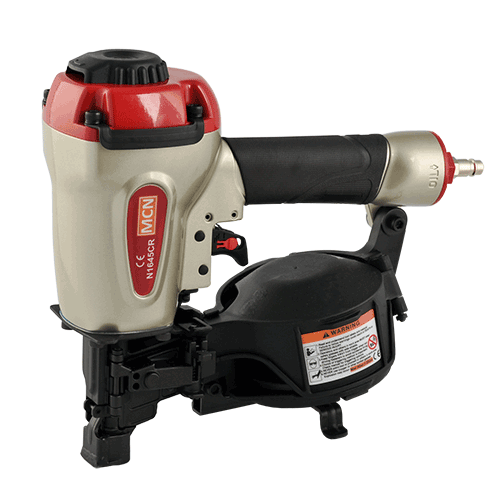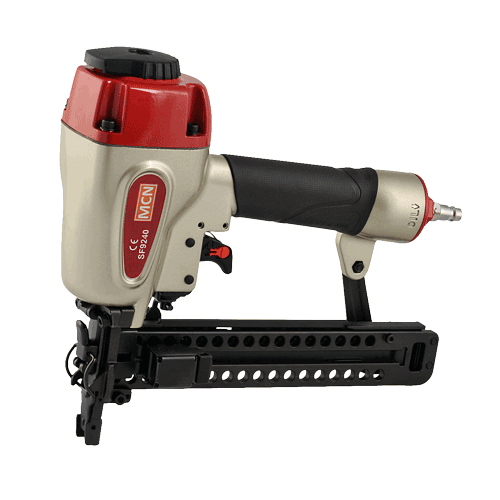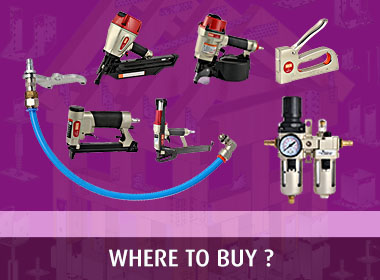QUESTIONS ABOUT TOOLS
01. My new nailer sometimes sparks when shooting nails
Is everything OK with the tool?
It is not normal to have sparks when firing a shot. It is caused by the contact of the metal of the tool with the metal of the nail. This situation always occurs with new tools. But with further use, the spark has a decreasing tendency, but there is always the possibility that it can spark.
02. How much oil should I use in the pneumatic nailer and stapler?
Two to three drops of oil each day is usually adequate. If the tool is used for a very long time at a very high speed, add another two or three drops in the second half of the day. Excessive lubrication will not damage the tool, but may cause skipping problems due to clogged parts with the tools.
03. Launching in the launcher area
My pneumatic nailer and stapler leaks air from the trigger area when the trigger is pulled and the tool will not cycle. When the trigger is released, the leak stops. What are the most common causes?
If it leaks through the trigger valve only when the trigger is pulled, the cause may be an internal leak in the head valve piston or trigger valve. The parts that cause this symptom are listed below from most common:
1) o-ring on the trigger
2) o-ring for the outer diameter of the head valve piston
3) head piston
4) cylinder cover assembly
04. Leakage through the exhaust space
My air nailer and stapler is leaking air from the exhaust area. What are the most common causes?
The parts that cause air leakage from the exhaust pipe are listed below from the most common:
1) o-ring on the inner diameter of the main piston
2) o-ring for the outer diameter of the head valve piston
3) Lower valve piston o-ring (cylinder seal)
4) lid
5) above the valve piston
05. Loss of performance
My pneumatic nailer and stapler can no longer shoot the fasteners completely, it seems to be losing power. Can it be fixed?
Most of the time, the tool simply needs tuning. A tune-up would consist of cleaning and fresh lube, along with installing the proper o-rings and trigger valve assembly. These actions will greatly improve cycle speed and tool energy. If troubleshooting does not resolve the problem, some other components should be checked:
1) Spring on the valve piston
2) Driver Piston Assembly – check that the driver is not bent and is driven smoothly inside the carrier channel
3) Air pressure too low – check compressor level and power
06. Bending the nail
Why does my nailer bend nails?
Most often when the tool bends nails it is caused by insufficient driving power caused by worn o-rings or lack of lubrication. The best way to correct low drive power is to clean the interior of the tool and install the appropriate o-rings with a fresh lube ring. Other possible causes of nail bending are:
1) Piston – The Piston is expected to show obvious wear at the tip. If it looks like that, it’s probably a bug.
2) Driver piston assembly – check for loose piston threads in the piston.
3) Fasteners – faulty, incorrectly aligned angles, incorrect attachment of the application.
4) The air pressure is too low
07. The piston will not return
The piston that shoots the nails does not go back, it remains stuck in the bottom part of the tool extended. What is wrong ?
First you need to understand the symptom. There are two separate errors that could cause a similar case.
1) The piston is fully extended from the head and will not return at all unless the air supply is disconnected from the tool. Check that the piston is straight and not bent inside the bearing channel.
2) The piston returns, but only partially, not enough to allow the connector to be killed well. This usually indicates sluggishness, due to lack of lubricant, worn piston and cylinder o-rings. A complete rebuild with relevant parts would be the best option. The individual parts that should be considered to be replaced are as follows:
A) Lower cylinder o-ring
B) Driver piston O-ring
C) Stops
08. Omission or Failure
My pneumatic nailer and stapler skips or fails. It serves, but there are no connecting elements or they only occur periodically. Are the connecting elements the cause?
When dealing with aligned fasteners, factors such as alignment angle and fastener spacing can affect the ability of the tool to properly feed the fasteners. However, this is usually an indication that the tool is slow and most likely needs tuning. A tune-up involves a complete cleaning and lubrication, along with the installation of the proper o-rings would solve most misfire problems due to lack of shot velocity. Additional parts that may cause leakage that are not included in most o-rings are:
1) Stops
2) Printed springs (only for belts and staplers)
3) Slider assemblies (belt winders and staplers only)
4) Check the correct setting of the tray. Example: the stack must be
set to the corresponding nail length
5) Tension compression springs and sliding springs
09. Removing jammed paper
How can I clear jammed nails and staples from an air tool?
This can vary from tool to tool, depending on the design. Usually, the jam that has occurred is located between the piston and the nose. This causes a jam that needs to be released. There is nothing scientific about this process. Most jams can be cleared by pushing the plunger back into the tool. Safety: first disconnect the tool from the air supply with the hoses. Push the controller up and behind the stuck retaining mechanism, place the punch on the tip of the mechanism’s piston which is protruding from the nose and tap the punch with the hammer.
Other causes of jamming:
• The piston channel is torn out: Replace the nose
• Incorrect dimensions. Use only the correct mounting dimensions
• Bending. Replace the fasteners
• Free magazine/nos. Tighten all screws
• Non-functional controller. Replace the controller
NOTE: only hit the striker as this is the hardest part. It is also the only moving part in the area. If you run into a stuck fastener, the repair may deteriorate. Smaller tools such as staplers, staplers can be disassembled through the nose to release jammed paper.
10. Fast running controls
When using the Pneumatic Nailer and Stapler quickly, some nails will be hammered well, but some will not be hammered well. Is there a problem with my compressor?
Probably not. Air volume is the problem, not pressure. Restrictions in the air line will and can cause a pressure drop as the tool is used in rapid operation. When there is a pressure drop, the power of the drive will decrease and the fasteners will move in the form of a staircase. This means that the first fastener will be driven all the way – the next fastener will be a little higher, with the next fastener even higher.
Make sure you have the correct air hose requirements. Air supply hoses should have a minimum working pressure of 10 bar (150 psi) or 150% of the maximum pressure developed in the air supply system, whichever is greater. A good quality air hose with a minimum ID of 5/16″ must be used. Air hoses should always be kept as short as possible.
For proper operation, a filter, regulator and lubricant should always be included in the air system. The filter prevents excessive tool wear and corrosion by trapping pipe, dirt, solid lubricants, oil, moisture and other components. The removal of moisture will prevent the air technology from freezing when operating in low temperatures. The regulator is the most important requirement for proper tool function and proper air pressure for the job. If the tool is over-pressurized, tool wear will increase significantly.
If the tool is under pressure, it will not perform satisfactorily. Heavy lubricants used in manufacturing or lubrication during a routine maintenance check cannot be expected to remain in the tool indefinitely. As a result, it is essential to use a pipe lubrication device that injects an oil mist into the air intake.
Check the restrictions for accessories and air technology. Even smaller compressors can support a blast of at least 10-15 nails before the pressure is reduced enough to affect drive power. Limitations may be moisture, ice, dirt build-up, or even air engineering equipment too small to support tool volume requirements.
11. Setting the depth of the nail
My nailer drives the nails too deep. When I reduce the pressure on the nail shots the tool will not feed the nails. Can I prevent this?
Yes. Reducing the air pressure to reduce nail penetration leads to irregular results. When the pressure is so low that it does not drive a long nail, it is basically not filled with enough air to function properly. Then he starts skipping or feeding erratically. The best way to solve this problem is some kind of depth control that can be used at normal air pressures. This depth control is usually a setting on the outside of the instrument.
12. Suggested air pressure
How much air pressure should I use on my nailer and stapler?
Read the operation and maintenance manual for minimum to maximum ranges. Maximum ranges are also noted on the outside of the tool for safety reasons. However, for best results and extended tool life, always use the minimum amount of pressure necessary to properly fill the fastener. The amount of pressure required varies greatly depending on the thickness and length of the material being fastened and the length of the fastener.
13. Water inside the instrument
How did water get into my Nailer and Stapler?
Any water inside the tool is a direct result of natural condensation that eventually settles in the tool, compressor tanks and air hoses. Compressor tanks and air hoses should be drained daily for optimal performance; and even more often during cold or very wet conditions.
14. Water from the compressor
My compressor and hoses fill up with water that ends up in my air tools. Is there something wrong with my compressor?
Not. Water in the tanks and hoses of the compressor is the result of natural condensation, which can then also form in the tool. The severity of water accumulation can vary greatly depending on the working conditions; especially at high humidity or at low temperatures. When humid, moist air passes through the pump and water slowly collects at the bottom of the tanks. Cold temperatures are the hardest. Cold air is drawn in through a very hot pump and heated. This hot air is then pumped through hundreds of feet of very cold hose to reach the instruments. This results in excessive condensation inside the hoses, which is transferred through the hose and deposited in the air tools.
During downtime for air tools, water will pool in low areas of the hose and freeze, causing severe airflow restrictions that will cause the tool to suffocate. Water vapor that has reached the air tool will freeze in the head valves and cause a slow cycle. Compressor tanks and hoses should be drained several times a day under these conditions.
15. Slow down in cold weather
My air tools become slow and won’t work in cold weather. When it’s warmer it works well. What can cause this problem?
When pneumatic nailers and staplers become sluggish during colder weather, it is almost always due to moisture and water in the tools, which can cause icing, especially in the main valve area. Outside temperatures below 0°C can cause freezing conditions in tool heads in high-speed applications. “Winter” lubricants are available on the market. These lubricants are used as a replacement for your daily lubricant only in the colder months. These lubricants act as antifreeze on the nail. Some of them can’t even be used in air tanks, they should be put directly into the air tool in the air equipment, and the nail should have the same shot speed as the normal lubricating oil.
16. Leaking through the nose
The tool draws air through the nose when the trigger is pulled. The piston will not return completely.
Stop cracked or damaged. Replace the stop.• Damage to the piston or cylinder. Replace the damaged part.• Piston O-ring is worn or damaged. Replace the o-ring.• Air pressure is too low or restricted. Check the air lines / compressor. Limitations may be moisture, dirt, or hoses and accessories too small for the volume requirements of the tool.• Guide lock is bent or damaged at end of travel. Replace the fuse of the controller.• Dirt / tar forms on the fuse. Disassemble and clean the nose and fuse.• The air exhaust system is clogged with dirt or old lubricating oil.• Lack of lubrication. Clean and lubricate the tool, replace worn o-rings.• Check the valve seal. This is an o-ring that is on the outside diameter of the cylinder sleeve and should be installed through the holes located about 2/3 of the way down the sleeve. The o-ring should be in the groove above the holes.
OUR BUSINESS PARTNERS
QUICK MESSAGE FOR US
_____
do you want to ask something? do not hesitate to contact us
YOU KNOW WHAT, WE KNOW HOW TO CONNECT PROFESSIONALLY




































































